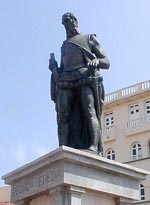
Visitors to Cartagena can hardly fail to notice
the larger-than-life bronze statues of a semi-naked
Indian maiden that stands on a traffic island
near Chambacu, and an equally impressive statue
of a Conquistador that stands in the Plaza de
los Coches. Their true lives are shrouded in mystery
and legend, though enough facts have survived
to ensure their immortality as a historical figures.
Don Pedro de Heredia: Spanish Conquistador,
and founder of Cartagena.

As
a young man, son of a rich family in Madrid,
six men tried to assassinate him but he was
able to defend himself. The fight left him with
a disfigured face. He hunted down three of his
attackers and killed them before fleeing to
Santo Domingo, and later Santa Marta in Colombia.
In 1532 he returned to Spain, where he gained
royal approval to invade the Bay of Cartagena
and found a city. He landed on 1 June 1533,
with 150 men and 22 horses. At that time there
were several villages of the Mocana Indians,
including the villages of Cospique in present-day
Mamonal, Bahaire on Isla Baru, Carex on Isla
Tierrabomba, and Calamari, the largest village,
stood on the sandy inner shore of Cartagena
Bay, the site of present day Centro Cartagena.
Heredia attacked their stockades, which were
fortified with palisades of wooden stakes on
which the Indians often displayed the impaled
decapitated heads of their enemies. The leaders
of the Native Indians were Codego and Carex,
with whom he eventually negotiated a pecae treaty.
He befriended an old man named Corinche and
persuaded him to guide him to Galerazamba, but
the he led him to an ambush in Turbaco that
nearly cost Heredia's life. A 22 year old Indian
woman slew eight Conquistadores with her own
hands, and Heredia was saved from certain death
only by the brave intervention of his comrade
Francisco Cesar. With the help of "La India
Catalina", a Native Indian Princess fluent in
both the Spanish and Indian tongues, he set
about conquering and ruling the area around
Cartagena, including Turbaco and the Magdalena
River. He looted Indian graves in the Sinu River
area, and his spoils from Galerazamba (now known
as Zamba, just a few miles from Cartagena, near
Totumo) included a solid gold porcupine weighing
132 pounds - the heaviest gold object plundered
durung the Conquest.
Heredia
was once taken prisoner by another conquistador,
Sebastian de Belalcazar. He led several long
and arduous expeditions into the mountains of
Antioquia, and was governor of Cartagena for
22 years. Recalled to Spain to face charges
that he had abused his power, he sailed for
Spain in 1544, but the ship sank within sight
of Cadiz. He tried to swim ashore, but his body
was never found. His statue, erected in 1963,
was sculpted by Juan Avalos.
La
India Catalina: Indian Princess, caught between
two cultures.
According
to an early account written by Juan de Castellanos,
Catalina was a young girl, and daughter of a
cacique, or native chief, when she was taken
prisoner by Spanish Captain Diego de Nicuesa,
in Galerazamba, not far from Cartagena. Nicuesa
took her to Santo Domingo where she was sold
as an orphan to a high ranking Spanish official.
He baptised and educated her, raising her as
if she was his own. When her adoptive mother
died, and her only sister was about to marry,
she fell in love with a Captain who promised
to bring her to her homeland again. Heredia
took her aboard in Santa Marta with the knowledge
that she was fluent in both Spanish and the
native tongue, when he came to found the city
of Cartagena, and conquer and plunder the tribes
living nearby. Catalina was 26 years old when
she arrived. Although Heredia used her as an
interpreter in his successful campaigns to subjugate
the natives, the death toll probably would have
been higher had Catalina not been present. A
rumour persists to this day that she and Heredia
were lovers. Whatever relationship she had would
have came to an end when she married Heredia's
nephew, Alonso Monta˝Ús. Later, as chronicled
in the writing of Maria Del Carmen Gomez, she
testified against Heredia when he faced charges
including theft of gold and mistreatment of
Indians. Catalina moved to Seville in Spain
where she disappears from the historical record.
Today, her 190 kg, 2.95m tall bronze statue
sculpted by Hector Tito Lombana and Eladio Gil
Zambrana is synonymous with Cartagena and its
annual International Film Festival. It stands
just outside the city wall, on Avenida Venezuela,
near the bridge over Laguna de Chambac˙, Cartagena.
|